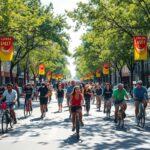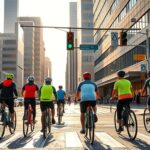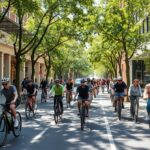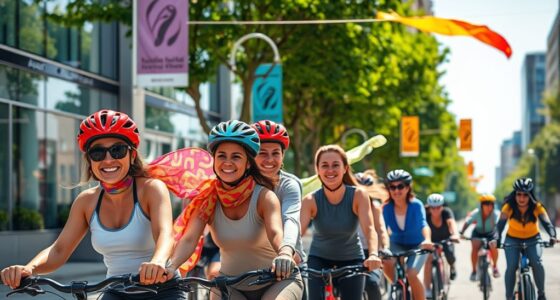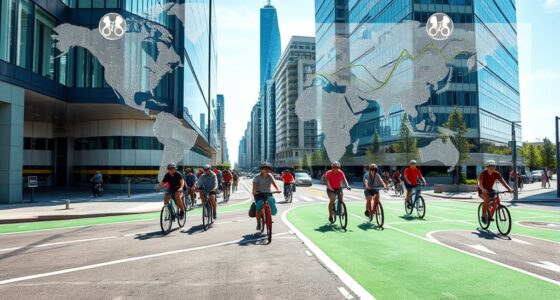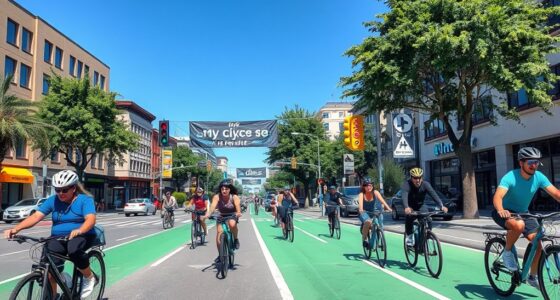School streets create safer environments by reducing traffic and slowing vehicles near schools, making it easier for children to walk, bike, and play safely. They often include measures like speed bumps, pedestrian zones, and clear signage to control traffic flow and protect pedestrians. Community involvement shows a shared commitment to student safety and neighborhood well-being. If you want to learn how these measures can transform your local school area, keep exploring the key strategies behind school streets and safety.
Key Takeaways
- School Streets transform busy roads into safe zones, reducing traffic and protecting students during school hours.
- Traffic calming measures like speed bumps and narrowed lanes slow vehicles, increasing driver awareness near schools.
- Designated pedestrian zones allow children to walk, bike, and play safely, minimizing accidents.
- Infrastructure, signage, and barriers guide drivers and pedestrians, enhancing safety and reducing confusion.
- Community involvement in School Streets demonstrates commitment to safety and encourages neighborhood-wide safety initiatives.
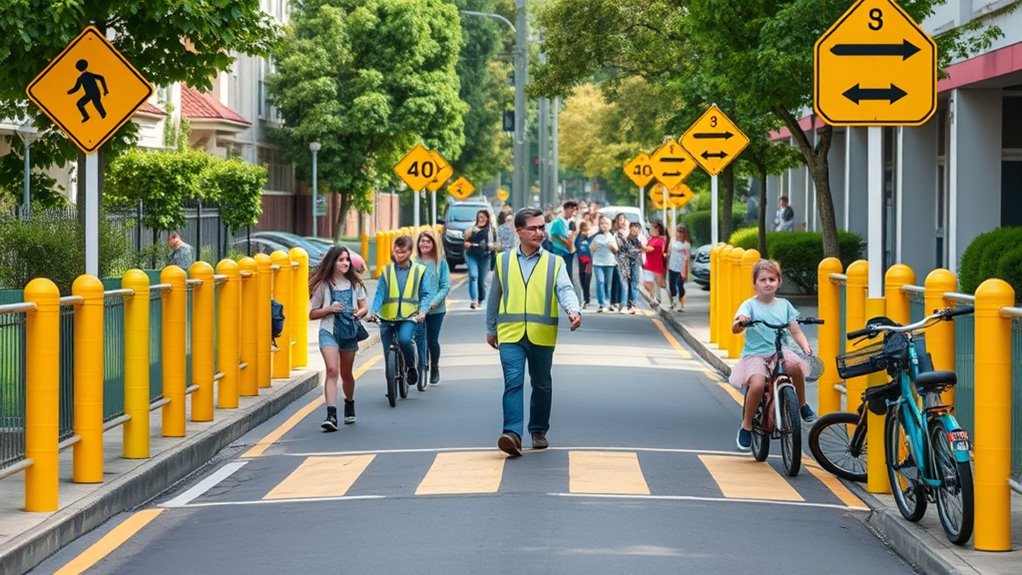
School streets are becoming vital for ensuring student safety and reducing traffic congestion around schools. When you implement measures like traffic calming, you’re actively transforming busy streets into safer environments for children. Traffic calming involves physical design features such as speed bumps, chicanes, and narrowed lanes that slow down vehicle speeds. These features are essential because they make drivers more aware of their surroundings and encourage responsible driving near schools. By integrating traffic calming techniques, you create a more controlled traffic flow that prioritizes pedestrian safety, reducing the likelihood of accidents.
Traffic calming features like speed bumps and narrowed lanes make drivers more aware and promote safer, more responsible driving near schools.
One of the most effective ways to enhance safety on school streets is by establishing designated pedestrian zones. These zones are areas where vehicle access is restricted during school hours, allowing children to walk, bike, or play without the constant threat of moving cars. When you designate pedestrian zones, you give students a safe space to cross streets and move around freely. This not only reduces the risk of traffic-related incidents but also promotes healthier, more active lifestyles among young students. Pedestrian zones also signal to drivers that they’re entering a zone where caution is paramount, prompting them to slow down and pay attention.
Creating pedestrian zones often involves installing barriers, signage, and curb extensions that clearly demarcate safe crossing points. These measures help guide both drivers and pedestrians, reducing confusion and increasing safety. When you prioritize pedestrian zones, you foster a sense of community and encourage parents and children to walk more often, decreasing the number of cars parked or idling near school entrances. This shift can considerably cut down on traffic congestion, making the area more accessible and less stressful for everyone.
Furthermore, school streets with traffic calming features and pedestrian zones serve as practical demonstrations of a community’s commitment to safety. They send a clear message that children’s well-being comes first, inspiring other neighborhoods to adopt similar measures. When you actively participate in designing and supporting these initiatives, you’re helping create a more secure environment where students can arrive at and leave school safely. As a result, both traffic hazards and congestion diminish, making the neighborhood a more inviting place for families and pedestrians alike.
Implementing traffic calming strategies can also encourage a sense of ownership and responsibility among residents, further enhancing safety efforts.
Frequently Asked Questions
How Are School Streets Funded and Maintained Long-Term?
You can find that school streets are typically funded through local government budgets, grants, or community initiatives. Funding mechanisms often include city funds or partnerships with local organizations. Maintenance responsibilities usually fall on city departments or school authorities, ensuring the streets stay safe and accessible. Long-term, consistent funding and clear responsibilities are essential for ongoing upkeep, so you should stay engaged with local officials to support and advocate for these resources.
What Are the Legal Rights of Residents During Street Closures?
During street closures, your resident rights are safeguarded by local street closure policies, which typically allow residents to voice concerns or request exemptions. You have the right to access your property and participate in public consultations. It’s important to stay informed about the specific policies in your area, communicate with local authorities, and attend community meetings to ensure your rights are respected and your concerns are addressed during street closures.
Can Temporary School Streets Be Converted Into Permanent Fixtures?
Yes, temporary school streets can be converted into permanent fixtures if the street design is adjusted and the community shows strong involvement. You should gather feedback from residents and local stakeholders to make sure the change benefits everyone. City officials typically review traffic data and community support before making such decisions. Your active participation and collaboration with local authorities can help transform temporary measures into lasting, safe, and accessible street designs.
How Do School Streets Impact Local Emergency Response Times?
School streets can slow down emergency access and disrupt traffic flow during peak hours. You might find that emergency vehicles face delays maneuvering around closed or restricted areas, which can be critical in urgent situations. To minimize this, it’s essential to design school streets with clear, accessible routes for emergency response, ensuring that traffic flow remains smooth and emergency access isn’t compromised while prioritizing student safety.
What Community Engagement Strategies Are Most Effective for Implementation?
You can boost community engagement by hosting regular community meetings where residents, parents, and local officials share their concerns and ideas. Building strong stakeholder partnerships is also key, as collaborating with schools, businesses, and advocacy groups fosters trust and shared responsibility. These strategies make implementation smoother, ensuring everyone feels involved and committed to the success of school streets, ultimately creating safer, more accessible environments for all.
Conclusion
You might think closing streets around schools just reduces traffic, but it actually creates safer, more inviting spaces for kids to walk and bike. Studies show that when streets are temporarily closed during school hours, accidents drop markedly, and community spirit improves. So, instead of dismissing School Streets as mere inconvenience, consider how they transform neighborhoods into safer, healthier places. It’s not just a theory — it’s a proven way to protect and empower our children.



